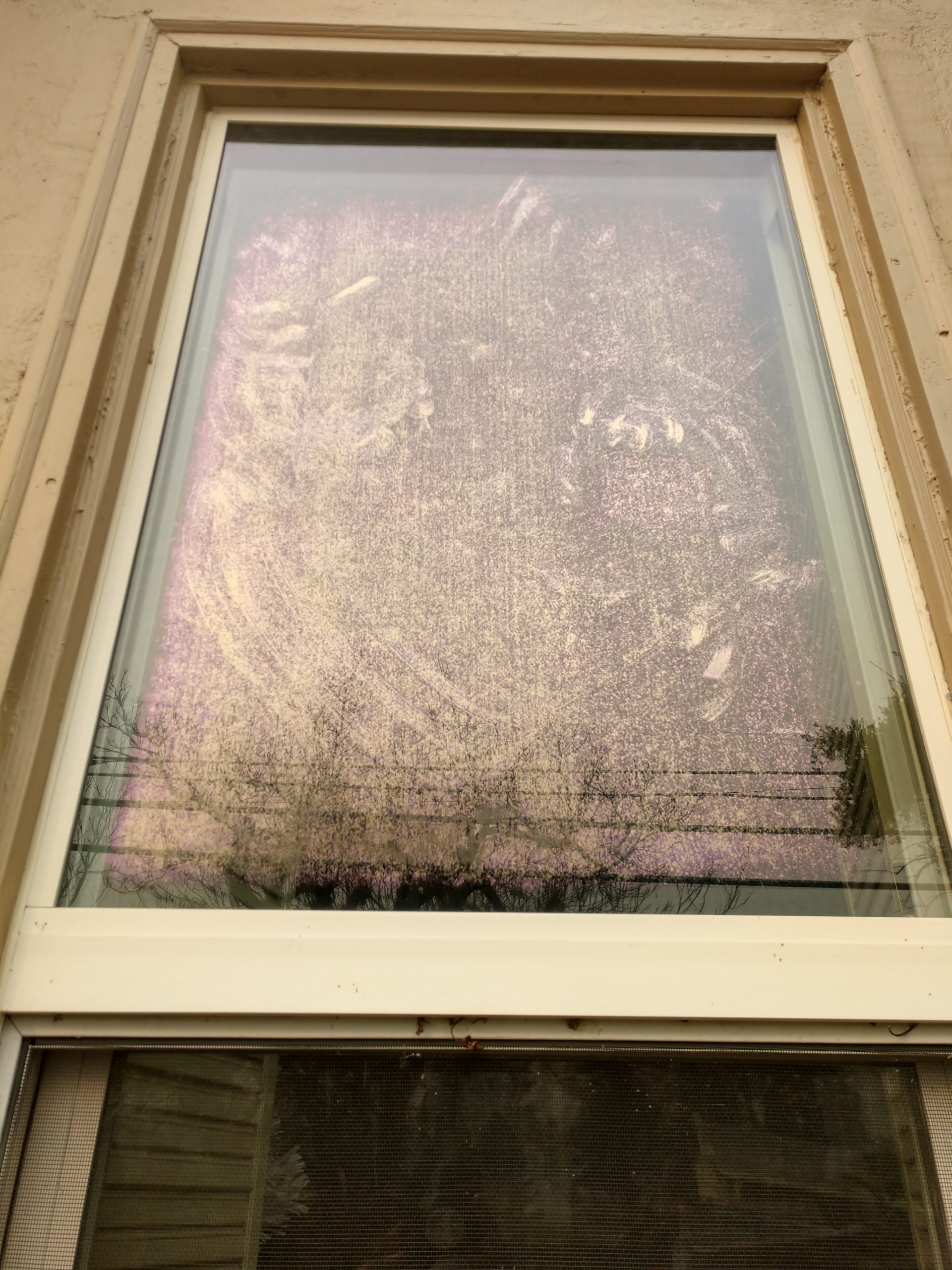Everyone of the public needs to know that there is no such thing as PERFECT GLASS OR WINDOWS that come from the manufacturer. Heat-Treated Glass – Pre-existing Liability For Scratches Etc. on Heat-Treated Glass (This includes both Fully Tempered and Heat-Strengthened glass)
Due to the widespread problems related to poor quality Heat-Treated glass. This also includes glass with
- Flipped IG units facing wrong side (Dark Purplish Argon Color facing you)
- Finger prints and Scratches in between IG units (Cannot be removed)
- Broken Seals (Water Condensation between Glass)
- Broken Seals (Do too to much pressure adding Argon between the glass)
- Glass Scratches (Lathing Wire)
- Micro-Loop detecting debri left under the glazing process
Although a hands-on examination of the actual problem is required to conclusively determine the cause, there are several commonly occurring trends. Listed below are some of the more frequent causes of poor glass produced.
INTERIOR SCRATCHES
- Windows being delivered to the project with defects already on the glass are rare, but this does occur. This damage usually occurs during window fabrication, in transit to the project, or during the installation of the window.
- At times, defects are present between the glass (inside the IG unit). Obviously, this type of defect occurred before or during the fabrication of the IG unit.
The element manganese found within glass will remain colorless as long as it does not oxidize to form manganese oxide. However, radiation from the sun will cause manganese to oxidize. Glass exposed to sunlight for a long period of time will turn purple if it contains manganese.
- Sheetrocking crews at times scratch the glass while removing splattered taping mud from the window. If they use a contaminated or rusted broad-knife to remove this excess mud, scratches often result. The fact that the window is usually dry at this time also contributes to the resulting scratches. Touch-up crews doing texture patches are at times guilty of the same type of scratches.
- Texture crews, when sanding the walls and jams, can scratch glass if they let their sanding block hit the glass. This usually happens when a sanding block is used to sand the corners around the window jams where the wall meets the jam. The scratches are usually 4 to 6 in. from the sides of the window and 4 to 6 in. from the top. Rarely are scratches of this type found along the bottom of the window, as this area usually doesn’t require sanding. This type of scratch is also rare if the walls are framed with 2 x 6 studs (instead of 2 x 4), as the sanding block is not as likely to come into contact with the glass.
- Painters and other tradesmen can cause scratches by resting their ladders and other tools against the glass.
- Unqualified window cleaners can scratch glass by not using proven construction window cleaning techniques to remove construction debris safely.
- The most devasting scratches are caused by tempered glass defects. Often there is fabricating debris from the tempering process on the glass surface, which will cause scratching over the entire surface of the glass during normal construction window cleaning. This subject is covered in more detail in theGlass Quality section of this site.
EXTERIOR SCRATCHES
- As stated above, windows being delivered to the site with scratches are rare, but this does exist.
- Scratches can be caused by lathing wire being dragged across the glass during the installation of lathing wire and black paper.
- The application of plaster and stucco around the window, as well as plasterers attempting to remove plaster and stucco from the glass, can cause scratches.
- Painters and other tradesmen can cause scratches by resting their ladders and other tools against the glass.
- Unqualified window cleaners can scratch glass by not using proven construction window cleaning techniques to remove construction debris safely.
- The most devasting scratches are caused by tempered glass defects. Often there is fabricating debris from the tempering process on the glass surface, which will cause scratching over the entire surface of the glass during normal construction window cleaning.
It is accepted and understood by ALL parties that properly used Abrasive pads standard tools and techniques for restoration window cleaning process and can safely remove limited amounts of debris (hard water, light scratches, suction cup marks, dirt and grim, paint, pit marks, , etc..) from quality glass, without scratching the glass surface.
At times window glass can be put under extreme pressures of weight load from the building and could shift in ground settling or earth quack movements and cause the IG unit failures causing broken seals with fogging and staining issues between the glass. Another defect on glass would be a IG unit flipped in the factory to the wrong side and show a purplish tarnish coating look. Another defect you may see is when the glass was installed you may see finger prints in between the glass and is not removable.
Furthermore, it is accepted and understood that razor blades and scrapers will not be employed on all construction window cleaning and only cleaning method will be offered by DBA, The Window Cleaning Specialists. to remove any debris or hardwater from any glass surface. Plus, if this is a regular maintenance cleaning extra cost must be charged for this service of removing debris from all glass. Another contract must be signed for the removal of debris at this point.
NOTE: We are a Sole Proprietor and we do not have or carry a contractor’s license. California State Contractor Board Law requires to have their license do “Construction Cleanup Work”. Law states
Applicators we use when cleaning regular glass or windows are as follows:
D-63 – Construction Clean-up Contractor
California Code of Regulations
Title 16, Division 8, Article 3. Classifications
A construction cleanup contractor cleans up and/or removes from building grounds or structures any debris resultant from any construction project including but not limited to: concrete, dirt, scrap lumber, plaster, drywall, any paint or adhesive products from windows, floors, ceramic tile and bathroom fixtures.
If it is not water-soluble it won’t be removed by us.

